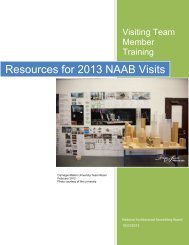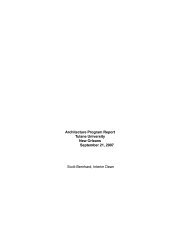NAAB Architecture Program Report (APR) 2013 - Tulane School of ...
NAAB Architecture Program Report (APR) 2013 - Tulane School of ...
NAAB Architecture Program Report (APR) 2013 - Tulane School of ...
You also want an ePaper? Increase the reach of your titles
YUMPU automatically turns print PDFs into web optimized ePapers that Google loves.
<strong>Tulane</strong> University<strong>Architecture</strong> <strong>Program</strong> <strong>Report</strong>September <strong>2013</strong>Grant Writing Assistance:The TSA is supported by Melissa Erekson from the Office <strong>of</strong> Corporate and Foundation Relations in theDevelopment Office. She researches grant opportunities and communicates these to faculty andstudents. She also provides substantial assistance in the submission process.Sabbatical, Course Release, and Unpaid Leaves <strong>of</strong> Absence:Faculty research and pr<strong>of</strong>essional development are also supported through sabbaticals and loweredcourse loads. Since 2008, the Dean <strong>of</strong> the <strong>School</strong> <strong>of</strong> <strong>Architecture</strong> and Provost <strong>of</strong> <strong>Tulane</strong> Universityhave approved paid Sabbatical and Fourth Year leaves for eleven faculty as they have worked tocomplete significant research, creative work and publications. Among these, for the first time in theschool’s history, all four faculty members on the tenure track have been afforded a full-semester paidleave <strong>of</strong> absence from teaching following their successful reappointment review (Fourth Year Leaves)to give them time and opportunity to develop their scholarly research and complete significantpublications and other works prior to tenure review.Policies, Procedures, and Criteria for Faculty Appointment, Promotion, and TenureThe following Policy on Promotion, Review, and Tenure was adopted by the faculty October 6, 2010.This supplements the University guidelines, as expressed in the Faculty Handbook, for appointmentand promotion <strong>of</strong> faculty. It is designed to inform faculty within the <strong>School</strong> <strong>of</strong> <strong>Architecture</strong> and personsoutside the school about the range <strong>of</strong> achievements and excellence in teaching, research, andpr<strong>of</strong>essional work deemed essential in making appointments and promotions. Some <strong>of</strong> the followingnotes assist in connecting university-wide expectations with particular applications and interpretations inthe pr<strong>of</strong>essional field <strong>of</strong> architecture.PreambleThe integrity <strong>of</strong> the Promotion, Review and Tenure process reflects the values and fairness <strong>of</strong> theschool’s faculty. Reviews must be conducted in a pr<strong>of</strong>essional manner addressing the particularcharacter <strong>of</strong> each discipline while demonstrating commitment to high standards <strong>of</strong> scholarship, creativepractice, teaching, and service.The <strong>School</strong> prepares undergraduate and graduate students for pr<strong>of</strong>essional practice, research,teaching, and industry and government service as these relate to planning and design <strong>of</strong> the physicalenvironment. The design pr<strong>of</strong>essions are complex, involving analytic, artistic, and technical abilities andbasic knowledge and understandings <strong>of</strong> the individual, society, and the environment, involvingintegration, synthesis, and creativity. At the <strong>School</strong> <strong>of</strong> <strong>Architecture</strong>, faculty contribute to futureknowledge through practice, research, and community service with an understanding <strong>of</strong> the past andpresent conditions in the discipline through an active process <strong>of</strong> exploration, probing the cultural,philosophical, aesthetic, and technical aspects <strong>of</strong> architecture.The <strong>Tulane</strong> <strong>School</strong> <strong>of</strong> <strong>Architecture</strong> values diversity. The strength <strong>of</strong> the school resides in a diversefaculty with a broad range <strong>of</strong> expertise, background, concerns, and approaches. Faculty are expectedto be cooperative and mutually supportive with a capacity to articulate a disciplined set <strong>of</strong> beliefs and todemonstrate their applicability to the built environment. Both agreements and differences within thefaculty are essential in helping students to attain the personal maturity to be able to synthesizetechnical, aesthetic, and cultural needs as architects.Academic freedom is fundamental to higher education. This freedom requires individual integrity andinitiative and carries with it responsibilities. Each faculty member must demonstrate intellectual andpr<strong>of</strong>essional integrity. Tenure review is primarily a faculty responsibility and it is important as thefoundation <strong>of</strong> a process that moves from the tenured faculty to the dean, provost, president, and Board<strong>of</strong> Trustees.23














